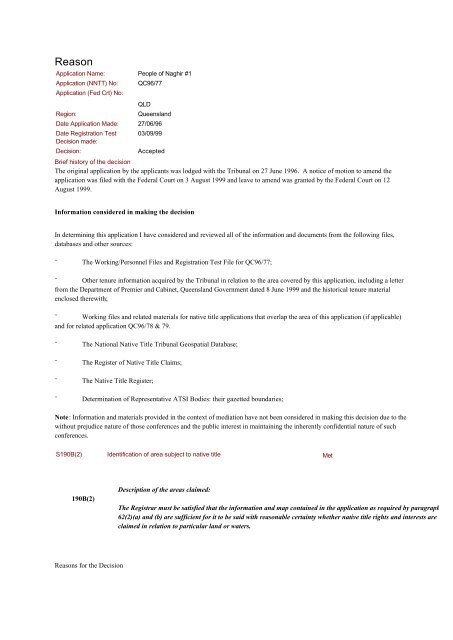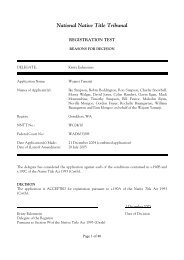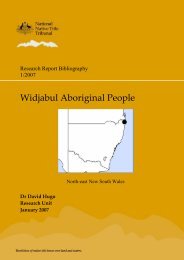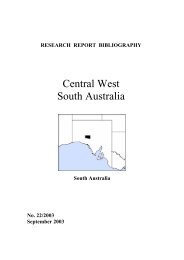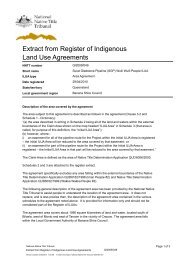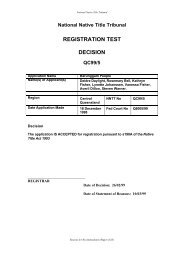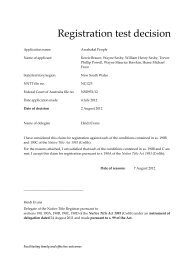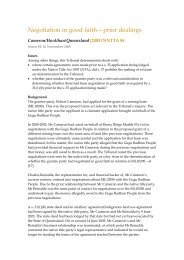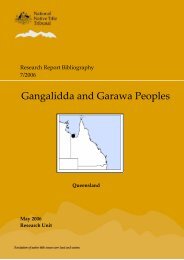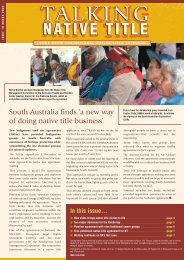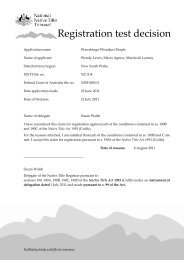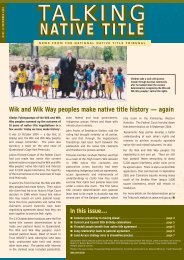Reason - People of Naghir #1 - National Native Title Tribunal
Reason - People of Naghir #1 - National Native Title Tribunal
Reason - People of Naghir #1 - National Native Title Tribunal
Create successful ePaper yourself
Turn your PDF publications into a flip-book with our unique Google optimized e-Paper software.
<strong>Reason</strong>Application Name: <strong>People</strong> <strong>of</strong> <strong>Naghir</strong> <strong>#1</strong>Application (NNTT) No:Application (Fed Crt) No:Region:QC96/77QLDQueenslandDate Application Made: 27/06/96Date Registration TestDecision made:Decision:03/09/99AcceptedBrief history <strong>of</strong> the decisionThe original application by the applicants was lodged with the <strong>Tribunal</strong> on 27 June 1996. A notice <strong>of</strong> motion to amend theapplication was filed with the Federal Court on 3 August 1999 and leave to amend was granted by the Federal Court on 12August 1999.Information considered in making the decisionIn determining this application I have considered and reviewed all <strong>of</strong> the information and documents from the following files,databases and other sources:¨The Working/Personnel Files and Registration Test File for QC96/77;¨ Other tenure information acquired by the <strong>Tribunal</strong> in relation to the area covered by this application, including a letterfrom the Department <strong>of</strong> Premier and Cabinet, Queensland Government dated 8 June 1999 and the historical tenure materialenclosed therewith;¨ Working files and related materials for native title applications that overlap the area <strong>of</strong> this application (if applicable)and for related application QC96/78 & 79.¨¨¨¨The <strong>National</strong> <strong>Native</strong> <strong>Title</strong> <strong>Tribunal</strong> Geospatial Database;The Register <strong>of</strong> <strong>Native</strong> <strong>Title</strong> Claims;The <strong>Native</strong> <strong>Title</strong> Register;Determination <strong>of</strong> Representative ATSI Bodies: their gazetted boundaries;Note: Information and materials provided in the context <strong>of</strong> mediation have not been considered in making this decision due to thewithout prejudice nature <strong>of</strong> those conferences and the public interest in maintaining the inherently confidential nature <strong>of</strong> suchconferences.S190B(2) Identification <strong>of</strong> area subject to native title Met190B(2)Description <strong>of</strong> the areas claimed:The Registrar must be satisfied that the information and map contained in the application as required by paragraphs62(2)(a) and (b) are sufficient for it to be said with reasonable certainty whether native title rights and interests areclaimed in relation to particular land or waters.<strong>Reason</strong>s for the Decision
External Boundaries and MapExternal BoundariesThe external boundaries <strong>of</strong> the claim area are described at A6 <strong>of</strong> the original application and at schedule B <strong>of</strong> the amended application.The claim area consists <strong>of</strong> a number <strong>of</strong> discrete parcels <strong>of</strong> land being the land area <strong>of</strong> <strong>Naghir</strong> Island (Naga) Mt Ernest Island, Peenacar Rock,Getullia Island, Suarji Island, Watson Cay, Travers Island and four other surrounding island/land masses in the seas <strong>of</strong> the Torres Strait. Seemy reasons under s62(2)(a)(i) for the full description <strong>of</strong> each island/land mass forming part <strong>of</strong> the claim area.The descriptions allocated to the island/land masses at A6 by referring to a lot, tenure type and plan number is the State’s unique identifyingreference for the relevant island/land mass forming part <strong>of</strong> the claim area. The description clearly identifies the area according to the State’sland identification and tenure record system, which enables members <strong>of</strong> the public to identify land according to the descriptions allocated bythe State to the land. I am satisfied that the descriptions allocated to the parcels making up the claim area sufficiently identifies the landaccording to the State’s public record system.I am further assisted by the map <strong>of</strong> the claim area attached to the original application (on which there is the parcel description next to eachclaimed island) and by the map <strong>of</strong> the claimed islands drawn by the State’s <strong>Native</strong> <strong>Title</strong> Unit provided as further information [refer to myreasons under s62(2)(a)(i)].I make this decision also bearing in mind that the areas so described are island or land masses surrounded by water in a remote area <strong>of</strong> thecountry, and the expense that would be occasioned surveying the same.Schedule B <strong>of</strong> the amended application also contains this statement:“By way <strong>of</strong> clarification, the boundaries <strong>of</strong> the application extend to the high water mark <strong>of</strong> all the claimed islands.”I am prepared to accept the statement at schedule B <strong>of</strong> the amended application as sufficiently describing the external boundary <strong>of</strong> theisland/land masses the subject <strong>of</strong> this claim.MapAs stated above in my reasons under s62(2)(a)(i), the original application contains two maps:· a map showing most <strong>of</strong> the claim area with the claimed island/land masses drawn with a fine black pen;· a locality map entitled “The Islands <strong>of</strong> Torres Strait”.A further map has also been provided to the <strong>Tribunal</strong> as additional information.The survey and other plans referred to in the description <strong>of</strong> the claim area in A6 <strong>of</strong> the application are not attached to the application. Themap attached to the application is not drawn to a scale, nor are there co-ordinate points on it. However, each <strong>of</strong> the claimed island/landmasses is depicted with reasonable clarity on this map, save for Lot 26 on Survey Plan TS233.Each <strong>of</strong> the relevant island/land masses are also identified on the map by the lot parcel and plan description allocated according to the State’spublic land identification system. Armed with the parcel description lot and plan references, it is possible to identify the external boundaries<strong>of</strong> the claim area on the earth’s surface with reasonable certainty.The applicant has also provided clarification as to the location <strong>of</strong> the boundaries <strong>of</strong> the claim area in a further map <strong>of</strong> the claim area enclosedwith a letter from his representative dated 28 July 1999. This map is drawn to a scale, was prepared by the State’s <strong>Native</strong> <strong>Title</strong> Unit andidentifies each island/land mass according to the parcel description referred to in A6 <strong>of</strong> the original application including Lot 26 on SurveyPlan TS233. The information on the state map corresponds to the information on the map <strong>of</strong> the surrounding island/land masses attached tothe original application.I make two specific points about the map attached to the application. Firstly, as already indicated, the parcel described as “Lot 26 on SurveyPlan TS233 (Travers Island)” is not depicted. Secondly, the parcels described as “Lot 7 on USL 36706” and “Lot 3 on USL 36706” are notclearly depicted on the application map, being very small land masses.The map attached to the application would in most instances be insufficient to satisfy me under this section (and the correspondings62(2)(b)) for the reasons stated above.However, the location <strong>of</strong> Travers Island and the other two land masses is clearly shown on the State map, together with the writtendescription, which corresponds with the description in A6 <strong>of</strong> the application. I have decided to accept the State map as additional
An exhaustive list <strong>of</strong> names <strong>of</strong> the persons in the native title claim group has not been provided. Consequently, the requirements <strong>of</strong>s.190B3(a) <strong>of</strong> the Act are not met.It is therefore necessary for the application to comply with s.190B (3)(b), which states that the application must otherwise describe thepersons in the native title claim group sufficiently clearly so that it can be ascertained whether any particular person is one <strong>of</strong> those persons.To meet this condition <strong>of</strong> the registration test the description <strong>of</strong> the group must be sufficiently clear so that it can be ascertained whether anyparticular person is a member <strong>of</strong> the native title claim group.At schedule A <strong>of</strong> the amended application, a description <strong>of</strong> the native title claim group is provided in these terms:“The people <strong>of</strong> <strong>Naghir</strong> being those persons who are descended from or adopted by James Mills and Sorogo. Sorogo was the son <strong>of</strong> Mori, thelast chief <strong>of</strong> <strong>Naghir</strong>.By letter dated 28 July 1999, the applicant’s legal representative elaborated upon what is meant by the process <strong>of</strong> adoption according to thenative title claim group’s tradition. The letter dated 28 May 1999 states:“Adoption means to take a person into a relationship, especially to take another’s child as one’s own. Adopted children are accorded thesame status and rights as birth children through customary law, including the right to inherit property. An adopted child will not, or at leastshould not, be told who his or her natural parents are until at least late adolescence. Children are frequently adopted from their biologicalparents to one <strong>of</strong> the biological mother’s siblings, and in so doing will be included in the cognatic descent group on wither account. Manyother possibilities exist however, and the only definitive rule about who may adopt one’s child is that it will never be a stranger <strong>of</strong> thebiological parents.”I have decided to accept the material in this letter as additional information clarifying the description in schedule A and as such to be includedon the Register <strong>of</strong> <strong>Native</strong> <strong>Title</strong> Claims.In this regard, I note that although s190B3(b) does not expressly stipulate that the description <strong>of</strong> the native title claim group needs to beencompassed entirely in the application, s61(4) may well have that effect by virtue <strong>of</strong> it providing that a native title determination applicationdescribe persons sufficiently clearly so that it can be ascertained whether any particular person is in a native title claim group.However, I have decided that strict adherence to the provisions <strong>of</strong> s61(4) in this circumstance would produce a manifestly unfair and unjustresult and the following factors are particularly relevant to my decision:1. the fact that the issue <strong>of</strong> adoption only arises in respect <strong>of</strong> children adopted by two named persons; and2. that there has been a grant by the State <strong>of</strong> a 30 year lease in favour <strong>of</strong> a corporation controlled by members <strong>of</strong> the native title claimgroup and the setting aside <strong>of</strong> two islands within the claim area as aboriginal reserves (refer search results at attachment A <strong>of</strong> the amendedapplication).I have consequently had regard to the obligations imposed on the <strong>Tribunal</strong> by s109 to “pursue the objective <strong>of</strong> carrying out its functions in afair, just, economical, informal and prompt way” (s109(1)) and the provisions <strong>of</strong> s109(3) which state that the <strong>Tribunal</strong>, in carrying out itsfunctions, is not bound by technicalities, legal forms or rules <strong>of</strong> evidence. In the circumstance <strong>of</strong> this application, I am relying on theseprovisions to enable the definition <strong>of</strong> adoption provided by letter to be read as part <strong>of</strong> the native title claim group description detailed in theapplication.Thus a person may be reckoned as a member <strong>of</strong> the <strong>Naghir</strong> native title claim group in two ways:· as a descendant <strong>of</strong> the two named ancestors;· as a person adopted by one <strong>of</strong> the two named ancestors.I am satisfied that the descendants <strong>of</strong> the named persons could be identified with minimal inquiry and as such, be ascertained as part <strong>of</strong> thenative title claim group.The aforementioned letter dated 28 July 1999 from the applicant’s legal representative provides further information as to how the principle<strong>of</strong> adoption stated in the application works. I am satisfied that this explanation is sufficiently clear for it to be possible to ascertain whetherany particular person has been adopted into the native title claim group by virtue <strong>of</strong>:· the elaboration on the meaning <strong>of</strong> adoption in the letter <strong>of</strong> 28 July 1999;· the statement <strong>of</strong> the one definitive rule in relation to when adoption is not permitted (ie to a person who is a stranger to the parents);and· the fact that it is only necessary to look at the adoption by the two named ancestors.I am therefore satisfied that this description constitutes an objective means <strong>of</strong> verifying the identity <strong>of</strong> members <strong>of</strong> the native title claim group
S190B(4) Identification <strong>of</strong> claimed native title Met190B(4)Identification <strong>of</strong> claimed native titleThe Registrar must be satisfied that the description contained in the application as required by paragraph 62(2)(d) issufficient to allow the native title rights and interests claimed to be readily identified.<strong>Reason</strong>s for the DecisionFor the application to pass this condition <strong>of</strong> the registration test I must be satisfied that the native title rights and interests claimed by thenative title claim group can be readily identified.The native title rights and interests claimed by the native title claim group are found in A9 <strong>of</strong> the original application.The native title rights and interests claimed may be broadly categorised as the right to:1. possess, occupy, use and enjoy the claim area, including the natural resources therein and “the abovementioned surrounding seas,islands and natural resources”;2. inherit, dispose <strong>of</strong>, or deal among themselves with their rights and interests in the claimed areas;3. to hunt, fish, forage and gather natural resources within the claimed areas;4. to trade in the natural resources;5. to conduct social, religious, cultural and economic life upon or within the claimed areas.I note that the first mentioned right refers to “the abovementioned surrounding seas, islands and natural resources”. I find that this provisioncan be ignored as the previous paragraphs <strong>of</strong> the claim do not mention any such seas or any islands or natural resources within thosesurrounding seas. It is clear from A6 and the maps attached to the application and provided as further information that the claim relates onlyto the land areas described therein and not to seas etc. (in this regard I refer to my reasons under s190B2). This interpretation also affects arequest made by the applicant’s representative in a letter <strong>of</strong> 28th July, 1999 to ignore reference to ‘the abovementioned surrounding seas’ forthe reasons stated above.To meet the requirements <strong>of</strong> s190B4 I need only be satisfied that at least one <strong>of</strong> the rights and interests sought is sufficiently described for itto be readily identified.I am satisfied that all <strong>of</strong> the rights and interests listed can be readily identified from the description provided at A9 <strong>of</strong> the original application.The application therefore meets the requirements <strong>of</strong> s190B4 and s62(2)(d).S190B(5) Factual basis for claimed native title Met
190B(5)Sufficient factual basis:The Registrar must be satisfied that the factual basis on which it is asserted that the native title rights and interestsclaimed exist is sufficient to support the assertion. In particular, the factual basis must support the followingassertions:(a) that the native title claim group have, and the predecessors <strong>of</strong> those persons had, an association with the area;(b) that there exist traditional laws acknowledged by, and traditional customs observed by, the native title claimgroup that give rise to the claim to native title rights and interests;(c) that the native title claim group has continued to hold the native title in accordance with those traditional lawsand customs.<strong>Reason</strong>s for the Decision
There are three criteria to consider in determining over all whether or not I am satisfied that there is a sufficient factual basis to support theapplicants’ assertion about the existence <strong>of</strong> the native title rights and interests listed at A9 <strong>of</strong> this application.At Schedule F <strong>of</strong> the amended application, the applicant states that the evidence produced to support the assertions in s190B5 is an affidavitat Attachment F <strong>of</strong> the amended application. This is an affidavit by the applicant, {name deleted} sworn 23 July 1999.I find the evidence <strong>of</strong> the applicant on these issues probative in light <strong>of</strong> his statement that he is a senior traditional elder <strong>of</strong> the claim group(refer para. 5 <strong>of</strong> the affidavit accompanying the amended application pursuant to s62), who is a traditional owner <strong>of</strong> land within the claim area(para. 6(b)).I have also identified the following further relevant and probative material with respect to the requirements s190B5:1) the relatively unique historical aspects <strong>of</strong> this claim as referred to in A5 and A11 <strong>of</strong> the original application (the truth <strong>of</strong> which issworn to by the applicant in the affidavit accompanying the original application), and in correspondence from the applicant’s representativedated 28 July 1999;2) the fact that <strong>Naghir</strong> Island is the subject <strong>of</strong> a special lease from the Crown in favour <strong>of</strong> the native title claim group and a number <strong>of</strong>aboriginal reserves (one dating back to 1926, over <strong>Naghir</strong> Island) have been proclaimed over various parts <strong>of</strong> the claim area (refer to my reasonsabove in relation to s190B2, under the heading “Internal Boundaries);3) the fact that dating back to 1910 until 1926, one <strong>of</strong> the two named ancestors {name deleted}, had been granted special leases by theCrown over <strong>Naghir</strong> Island (refer again to my reasons above in relation to s190B2, under the heading “Internal Boundaries”).I will now deal with each <strong>of</strong> the three criteria to be satisfied under this section.190B(5)(a) – that the native title claim group have, and the predecessors <strong>of</strong> those persons had, an association with the area.To be satisfied under this criterion, it must be evident that the association with the area is and was communal, that is, shared by a number <strong>of</strong>members <strong>of</strong> the native title claim group.· {name deleted} (23/07/99) provides a factual basis for the above condition in his statement by describing:· how he is a senior traditional elder <strong>of</strong> the native title claim group, and the owner <strong>of</strong> land on the claim area (para. 5 <strong>of</strong> affidavitaccompanying the application pursuant to s62 and para.6);· how members <strong>of</strong> the native title claim group (described as “traditional land owners”) have maintained their connections andassociations with the claim area and continue to occupy, enjoy and utilise the resources <strong>of</strong> the claim area (para. 4);· how “our” forefathers lived on the claim area before “us” and were also traditional owners <strong>of</strong> the claim area (para. 3);· examples <strong>of</strong> how the native title claim group have an acknowledged system <strong>of</strong> traditional laws and customs, namely, land ownership(para. 5), passing <strong>of</strong> land to others (paras. 5 and 6(b)), use and enjoyment <strong>of</strong> land and natural resources. {name deleted} gives the specificexample <strong>of</strong> his use <strong>of</strong> bamboo from the land for the manufacture <strong>of</strong> spears (para. 6(a));· traditional laws, customs and practices that he and other members <strong>of</strong> the native title claim group have observed and carried out on theclaim area, such as hunting, foraging, gardening, visiting culturally significant sites, conducting burials and tomb stone openings, participating infestivals and traditional dancing and being responsible on a daily basis for the care <strong>of</strong> the land (paras. 6(c) and 6(e));· the trade in which he and other members <strong>of</strong> the claim group have engaged in items such {name deleted} selling spears from <strong>Naghir</strong>bamboo at the Thursday Island Cultural Festival (para. 6(d)).I refer also to the statement at A5 <strong>of</strong> the original application to that the native title claim group is descended from “people who occupied theclaimed areas from time immemorial and from when the Island was annexed to the State <strong>of</strong> Queensland in 1879, and have continuouslyoccupied the claimed areas to present time”. I find this statement probative as to the claim group’s current association with the claim area,and the association <strong>of</strong> their predecessors with the claim area.I also reiterate that I find it probative that:· the Queensland State Government has granted to the native title claim group a special lease over part <strong>of</strong> the claim area, pointing tooccupation <strong>of</strong> the claim area by the group; and· one <strong>of</strong> the claim group’s two named ancestors was also granted leases over part <strong>of</strong> the claim area from 1910 to 1926, and subsequentlyto that an aboriginal reserve was proclaimed over the area until grant <strong>of</strong> the special lease to the Naga Tribal Torres Strait Islanders Corporation.Finally, I have taken note <strong>of</strong> the following assertions in correspondence (28/7/99) from the applicant’s representative in relation to therequirements <strong>of</strong> s190B5:“While no member <strong>of</strong> the native title claim group presently resides permanently on the claim area, the native title claim group presently enjoy,occupy, and use the claim area and are intimately associated with it. Part <strong>of</strong> that enjoyment is reflected through the holding by theircorporation <strong>of</strong> a thirty (30) year residential and commercial lease in respect <strong>of</strong> Lot 20 (<strong>Naghir</strong> Island). The native title claim group continue to
S190B(6) Prima facie case Met190B(6)Prima facie case:The Registrar must consider that, prima facie, at least some <strong>of</strong> the native title rights and interests claimed in theapplication can be established.<strong>Reason</strong>s for the Decision
‘<strong>Native</strong> title rights and interests’ are defined at s223 <strong>of</strong> the <strong>Native</strong> <strong>Title</strong> Act. This definition specifically attaches native title rights andinterests to land and water, and in summary requires:A. the rights and interests to be linked to traditional laws and customs;B. those claiming the rights and interests to have a connection with the relevant land and waters; andC. those rights and interests to be recognised under the common law <strong>of</strong> Australia.The definition is closely aligned with all the issues I have already considered under s190B5. I will draw on the conclusions I made under thatsection in my consideration <strong>of</strong> s190B6, rather than reconsider these requirements against each individual right and interest sought.Under s190B6 I must consider that, prima facie, at least some <strong>of</strong> the rights and interests claimed can be established. The term prima facie wasconsidered in North Ganalanja Aboriginal Corporation v Qld 185 CLR 595 by their Honours Brennan CJ, Dawson, Toohey, Gaudron andGummow JJ, who noted:"The phrase can have various shades <strong>of</strong> meaning in particular statutory contexts but the ordinary meaning <strong>of</strong> the phrase "prima facie is: "Atfirst sight; on the face <strong>of</strong> it; as it appears at first sight without investigation." [Citing the Oxford English Dictionary (2nd ed 1989)].I have adopted the ordinary meaning referred to by their Honours when considering this application.In deciding which native title rights and interests claimed can prima facie be established I have relied on the affidavit <strong>of</strong> {name deleted}(23/7/99), information contained in A5 and A9 <strong>of</strong> the original application and the statements in the letter from the applicant’s legalrepresentative dated 28 July 1999 under the heading “Section 190B5”. The content <strong>of</strong> this material is outlined in my reasons for decision ats.190B5.The rights and interests claimed by the native title claim group are set forth in A9 <strong>of</strong> the original application.I note also that it is stated in schedule E <strong>of</strong> the amended application that there is no change to the description <strong>of</strong> the native title rights andinterests except that “no native title rights or interests are claimed where such rights have previously been extinguished and suchextinguishment is not to be disregarded by virtue <strong>of</strong> sections 47(2), 47A(2) and 47B(2)”.I refer to examples <strong>of</strong> the evidence that prima facie support the claimed native title rights and interests – the context that this evidence wasprovided is detailed in my reasons for decision at 190B(5).· The right to possess, occupy, use and enjoy the claimed land and water areas including the natural resources therein to the exclusion<strong>of</strong> all others.The affidavit by {name deleted} illustrates how he and members <strong>of</strong> the claim group have exercised this right in his lifetime. It illustrates howhe and other members <strong>of</strong> the claim group have owned land within the claim area, according to traditional laws and customs. It also outlineshow members <strong>of</strong> the claim group have used and enjoyed the claim area including hunting, foraging, gardening, trading in natural resources.I note that as described in A9 <strong>of</strong> the application, this right refers to “the abovementioned surrounding seas, islands and natural resources”. Ifind that this provision can be ignored, as the previous paragraphs <strong>of</strong> the claim do not mention any such seas or any islands or naturalresources within the surrounding seas. It is clear from A6 and the maps attached to the application that the claim relates only to the landareas described therein and not to seas etc. (in this regard I refer to my reasons under s190B2). Indeed no reference is made elsewhere in theoriginal application (including in the definition <strong>of</strong> the area covered by the claim in A6 <strong>of</strong> the application) to surrounding seas, and I accept thatthe reference to same is an error or drafting mishap on the part <strong>of</strong> the author <strong>of</strong> the document.I therefore delete reference to “and the above mentioned surrounding seas, islands and natural resources” in this claimed right. Thisdeletion should give affect to the request made by the relevant legal representative in their letter <strong>of</strong> 24/5/99.· To inherit, dispose <strong>of</strong>, or deal among themselves with their rights and interests in the claimed areas.I find that the affidavit <strong>of</strong> {name deleted} dealing with the ownership and inheritance <strong>of</strong> land on the claim area establishes this right andinterest.· To hunt, fish, forage and gather natural resources within the claimed areas.I find that evidence in the affidavit <strong>of</strong> {name deleted} detailing that the native title claim group hunt over the land, forage the land, garden theland and otherwise use and enjoy the land and its natural resources establishes, on a prima facie basis, this right and interest. So far as fishingis concerned, although this activity is not specifically averred to in {name deleted} evidence, I find that the reference to hunting and using thenatural resources <strong>of</strong> the land, such as animal and plant life (para. 6(a)) sufficiently establishes this right. Even if it was not sufficient, I am <strong>of</strong>the view that the right to fish <strong>of</strong>f the shores is a right or interest which relies upon or is parasitic to the native title right to the claim areaestablished by the native title claim group and that it is therefore established on a prima facie basis.
S190B(7) Physical connection Met190B(7)Traditional physical connection:The Registrar must be satisfied that at least one member <strong>of</strong> the native title claim group:(a) Currently has or previously had a traditional physical connection with any part <strong>of</strong> the land or waters covered bythe application; or(b) Previously had and would reasonably have been expected currently to have a traditional physical connectionwith any part <strong>of</strong> the land or waters but for things done (other than the creation <strong>of</strong> an interest in relation to land orwaters) by:(i) the Crown in any capacity; or(ii) a statutory authority <strong>of</strong> the Crown in any capacity; or(iii) any holder <strong>of</strong> a lease over any <strong>of</strong> the land or waters, or any person acting on behalf <strong>of</strong> such holder <strong>of</strong> a lease.<strong>Reason</strong>s for the Decision
Under s 190B(7)(a) I must be satisfied that at least one member <strong>of</strong> the native title claim group currently has or previously had a traditionalphysical connection with any part <strong>of</strong> the land or waters covered by the application.The affidavit by {name deleted} establishes that:· he is a member <strong>of</strong> the native title claim group;· he is a senior traditional elder <strong>of</strong> the native title claim group, who owns land on the claim area that he will pass on to his childrenwhen he dies;· he participates in traditional aspects <strong>of</strong> cultural expression and conducts activities on the claim area. For example {name deleted} usesbamboo from the land for the manufacture <strong>of</strong> spears that he then trades, and visits and maintains the graves <strong>of</strong> his relatives on <strong>Naghir</strong>.I have also taken into account the information provided in correspondence (28/7/99) from the applicant’s representative (detailed more fullyabove 190B(5)) specifically:“While no member <strong>of</strong> the native title claim group presently resides permanently on the claim area, the native title claim group presently enjoy,occupy, and use the claim area and are intimately associated with it.”In considering the significance <strong>of</strong> this information I have drawn on the decision <strong>of</strong> His Honour Justice Lee in Ward v State <strong>of</strong> WesternAustralia 159 ALR 483. In that case, His Honour found that native title will continue where connection with the land is substantiallymaintained by a community which acknowledges and observes, as far as practicable, laws and customs based on the traditional practices <strong>of</strong> itspredecessors. (501.40-45) In deciding whether presence is sufficient to ground native title, one must look at the question from thestandpoint <strong>of</strong> the indigenous community i.e. in the light <strong>of</strong> demands <strong>of</strong> the land and the way <strong>of</strong> life <strong>of</strong> that indigenous community. (500.30)His Honour was <strong>of</strong> the view that the degree <strong>of</strong> presence amounting to occupancy will vary. The survival <strong>of</strong> such a society may depend uponoccupation that is sparse and wide-ranging. However, a truly random presence on land, unconnected with the economic, cultural or religiouslife <strong>of</strong> the community will not amount to occupation. Occupancy for the purpose <strong>of</strong> native title is not possession at common law but anacknowledged connection with the land arising out <strong>of</strong> traditional rights to be present on and use the land. Such occupancy [for the purposes<strong>of</strong> native title] need not be exclusive to one community and may be shared between several communities in some circumstances. (501.15-25)Based on the evidence <strong>of</strong> {name deleted} as extensively set out in my reasons under s190B5 and 190B6, I am satisfied that he is a member <strong>of</strong>the native title claim group and that his occupancy <strong>of</strong> the area is not a random presence on the land, unconnected with the economic, culturalor religious life <strong>of</strong> the community. Consequently, for the purpose <strong>of</strong> this section I consider {name deleted} has the requisite traditionalphysical connection.The requirements <strong>of</strong> this condition <strong>of</strong> the registration test are therefore met.S190B(8) No failure to comply with section 61A Met190B(8)No failure to comply with s61A:The application and accompanying documents must not disclose, and the Registrar must not otherwise be aware, that,because <strong>of</strong> s61A (which forbids the making <strong>of</strong> applications where there have been previous native title determinationsor exclusive or non-exclusive possession acts), the application should not have been made.<strong>Reason</strong>s for the Decision
For the reasons that follow I have formed the conclusion that there has been compliance with s61A.s61A(1) – <strong>Native</strong> <strong>Title</strong> DeterminationA search <strong>of</strong> the <strong>Native</strong> <strong>Title</strong> Register has revealed that there is no approved determination <strong>of</strong> native title in relation to the area claimed in thisapplicationS61A(2) – Previous Exclusive Possession ActsThe applicant has not excluded from the claim area any specific tenure or other class or type <strong>of</strong> tenure referred to in s23B <strong>of</strong> the Act.However, at schedule E <strong>of</strong> the amended application, the applicant makes the statement that “no native title rights or interests are claimedwhere such rights have previously been extinguished and such extinguishment is not to be disregarded by virtue <strong>of</strong> sections 47(2), 47A(2) or47B(2)”. I have already made certain findings about this statement at 190B2 (above) and also rely on these findings in this section.Historical TenureThe Department <strong>of</strong> Premier and Cabinet, Queensland Government has supplied historical tenure information with respect to <strong>Naghir</strong> Island,but did not provide any formal submissions under s190A(3) about this tenure in so far as it was relevant to the registration testing <strong>of</strong> thisapplication.Neither the applicant nor the <strong>Tribunal</strong> has obtained a detailed historical tenure search in relation to the balance <strong>of</strong> the claim area. Indeed,because <strong>of</strong> the remote, sparsely populated and likely simple tenure history <strong>of</strong> the remainder <strong>of</strong> the claim area, the expense and time involvedin obtaining a detailed historical search <strong>of</strong> tenure <strong>of</strong> the other islands appears unwarranted at this point. Six <strong>of</strong> the ten claimed island/landmasses are unallocated state land.The historical tenure information identifies a number <strong>of</strong> likely previous exclusive possession acts (“PEPAs”) being:· expired special leases in favour <strong>of</strong> one <strong>of</strong> the group’s ancestors, {name deleted}, between 1910 and 1926;· an expired special lease in favour <strong>of</strong> the Church.There are certain circumstances when prior extinguishment <strong>of</strong> native title rights and interests by the creation <strong>of</strong> an interest such as a PEPAmay be disregarded (and thus the requirements <strong>of</strong> s61A met notwithstanding the prior existence <strong>of</strong> such an interest).This is provided for in s61A(4) <strong>of</strong> the Act, which states that “subsection (2) and (3) [<strong>of</strong> s61A] does not apply to an application if:(a) the only previous exclusion possession act or previous non-exclusive possession act concerned was one whose extinguishment <strong>of</strong>native title rights and interests would be required by section 47, 47A or 47B to be disregarded were the application to be made; and(b) the application states that section 47, 47A or 47B, as the case may be, applies to itSchedule E <strong>of</strong> the amended application provides that “no native title rights or interests are claimed where such rights have previously beenextinguished and such extinguishment is not to be disregarded by virtue <strong>of</strong> sections 47(2), 47A(2) or 47B(2).”I am <strong>of</strong> the view that failing to specifically exclude the areas <strong>of</strong> land covered by these likely (prior) PEPAs is not a contravention <strong>of</strong> s61A asthe applicant has specifically stated in the application that sections 47(2), 47A(2) or 47B(2) apply.Should it be found that these sections are not applicable, the statement at schedule E (detailed above), has the effect <strong>of</strong> excluding from theclaim area any such extinguishing interest, including a prior PEPA interests.Current TenureThe Department <strong>of</strong> Premier and Cabinet, Queensland Government has supplied current tenure information with respect to <strong>Naghir</strong> Island, butdid not provide any formal submissions under s190A(3) about this tenure in so far as it was relevant to the registration testing <strong>of</strong> thisapplication.The tenure information to hand reveals that <strong>Naghir</strong> Island (Lot 20/TS228) is subject to a special lease which commenced on 16th May, 1991.The State <strong>of</strong> Queensland entered into this lease with the Naga Tribal Torres Strait Islanders Corporation for “residential and commercialpurposes”. In a letter dated 28/7/99 from the applicants representative it is noted that ‘<strong>Naghir</strong>’ has, in the past, been incorrectly spelt as ‘Naga’.I have examined a copy <strong>of</strong> the Special Lease Vol 7721 Fol 80 which is marked Attachment A to the application and was also provided by theDepartment <strong>of</strong> Premier and Cabinet, Queensland Government. The lease was issued pursuant to 203(a) <strong>of</strong> the Land Act 1962-1890 over 30years for “residential and commercial purposes”.
S190B(9) No extinguishment etc. <strong>of</strong> claimed native title Met190B(9)(a)Ownership <strong>of</strong> minerals, petroleum or gas wholly owned by the Crown:The application and accompanying documents must not disclose, and the Registrar must not otherwise be aware, that:(a) to the extent that the native title rights and interests claimed consist or include ownership <strong>of</strong> minerals,petroleum or gas - the Crown in right <strong>of</strong> the Common-wealth, a State or Territory wholly owns the minerals,petroleum or gas;<strong>Reason</strong>s for the DecisionAt Schedule Q <strong>of</strong> the amended application it is stated: “The native title claim group does not claim ownership <strong>of</strong> minerals, petroleum or gasto the extent to which the Commonwealth or the State owns such minerals, petroleum or gas and such ownership by the Commonwealth orState has wholly extinguished any native title rights in such petroleum, minerals or gas.”I am satisfied that this statement has the effect that the application complies with the requirements <strong>of</strong> S190B(9)(a).190B(9)(b)Exclusive possession <strong>of</strong> an <strong>of</strong>fshore place:The application and accompanying documents must not disclose, and the Registrar must not otherwise be aware, that:(b) to the extent that the native title rights and interests claimed relate to waters in an <strong>of</strong>fshore place - those rightsand interests purport to exclude all other rights and interests in relation to the whole or part <strong>of</strong> the <strong>of</strong>fshore place;<strong>Reason</strong>s for the DecisionThe area claimed does not include any <strong>of</strong>fshore area (refer to my reasons under s190B2, from which it is apparent that the external boundaries<strong>of</strong> the claim area do not extend to any <strong>of</strong>fshore areas). It is therefore not necessary for me to consider this section further.190B(9)(c)Other extinguishment:The application and accompanying documents must not disclose, and the Registrar must not otherwise be aware, that:(c) in any case - the native title rights and interests claimed have otherwise been extinguished (except to the extentthat the extinguishment is required to be disregarded under subsection 47(2), 47A(2) or 47B(2)).<strong>Reason</strong>s for the Decision
The application and supporting material and the <strong>Tribunal</strong>’s file do not disclose nor am I otherwise aware that the native title rights andinterests claimed in the application have been otherwise extinguished.In this regard I rely on the statement in schedule E <strong>of</strong> the amended application to the effect that “no native title rights or interests are claimedwhere such rights have previously been extinguished and such extinguishment is not to be disregarded by virtue <strong>of</strong> sections 47(2), 47A(2) or47B(2)”.I am satisfied that the requirements <strong>of</strong> this section have been met.S190C(2) Information etc required by sections 61 & 62 MetInformation, etc, required by section 61 and section 62:190C(2)The Registrar must be satisfied that the application contains all details and other information, and is accompanied byany affidavit or other document, required by sections 61 and 62.Details required in section 6161(3) Name and address for service <strong>of</strong> applicant(s)<strong>Reason</strong>s relating to this sub-conditionRequirements are met. Page 1 <strong>of</strong> the amended application identifies the single applicant and the address for service isdetailed at page 14 <strong>of</strong> the amended application61(4) Names persons in native title claim group or otherwise describes the persons so that it can be ascertainedwhether any particular person is one <strong>of</strong> those persons<strong>Reason</strong>s relating to this sub-conditionRequirements are met. The amended application describes the native title claim group at Schedule A, page 2 <strong>of</strong> theamended application. In my view the description <strong>of</strong> the claim group at schedule A, elaborated upon in a letter from theapplicant’s legal representative dated 28 July 1999 is sufficient for it to be ascertained whether any particular person isone <strong>of</strong> those persons. I have reached this view for the reasons contained in my decision at s.190B3.
61(5) Application is in the prescribed form Note that in relation to pre 30.09.98 applications, the application does not needto be in the prescribed form as required by the amended Act. Note also that pre 30.09.98 applications are deemed tohave been filed in the Federal Court., lodged in the Federal Court, contain prescribed information Note also that “prescribed information” is that which is required by s62 as set out in the text <strong>of</strong> this reasons document under “Detailsrequired in section 62(1)”., and accompanied by prescribed documents and fee<strong>Reason</strong>s relating to this sub-conditionRequirements are met.The amended application is in the form prescribed by Regulation.5(1)(a) <strong>Native</strong> <strong>Title</strong> (Federal Court) Regulations 1998.As required under section 61(5)(b), the amended application was filed in the Federal Court. The original application istaken to have been made to the Federal Court in accordance with Table A, Application, Savings or TransitionalProvisions, item 6 case 3.The application meets the requirements <strong>of</strong> section 61(5)(c). I refer to my reasons in relation to s62.As required by section 61(5)(d) an affidavit and map as prescribed by s62(1)(a) and s62(2)(b) respectively accompanythe application. I refer to my reasons below in relation to s62(1)(a) and s62(2)(b) <strong>of</strong> the Act.I note that section 190C(2) only requires me to consider details, other information, and documents required by section61 and 62. I am not required to consider whether the application has been accompanied by the payment <strong>of</strong> a prescribedfee to the Federal Court.Details required in section 62(1)62(1)(a)Affidavits address matters required by s62(1)(a)(i) – s62(1)(a)(v)<strong>Reason</strong>s relating to this sub-conditionRequirements are met.{name deleted} has sworn an affidavit addressing the matters required by s62(1)(a)(i) – (v). The affidavit was sworn on23 July 1999. It is appended to the amended application. The affidavit meets the requirements <strong>of</strong> s62(1)(a)(i) tos62(1)(a)(iv), at points 1, 2, 3 and 4 respectively.Point 5 <strong>of</strong> the affidavit refers to the basis <strong>of</strong> the applicant’s authorisation, and consequently the requirements <strong>of</strong>s62(1)(a)(v) are satisfied.For the reasons set out above, I have formed the view that the application complies with the requirements <strong>of</strong> thissubsection.62(1)(c)Details <strong>of</strong> any traditional physical connection (information not mandatory)
Comment on details providedThe native title claim group provides some detail <strong>of</strong> traditional physical connection in the original application at A9being a statement <strong>of</strong> some <strong>of</strong> the traditional laws and customs observed. There is also some detail <strong>of</strong> traditional physicalconnection in A5 <strong>of</strong> the amended application.Further detail is contained in an affidavit by {name deleted} dated 23 July 1999 at attachment “F” <strong>of</strong> the amendedapplication. This affidavit outlines his traditional connection with the land, and the traditional connection <strong>of</strong> the claimgroup and their predecessors. I have referred to this information in more detail in my reasons for decision in relation totest conditions 190B(5), 190B(6) and 190B(7).Details required in section 62(2) by section 62(1)(b)62(2)(a)(i)Information identifying the boundaries <strong>of</strong> the area covered<strong>Reason</strong>s relating to this sub-conditionApplication passes the conditionRequirements are met.The boundaries <strong>of</strong> the area covered by the application are identified by the following information:· A map attached to the original application showing the claim area. This map does not show co-ordinates for thearea, nor does it have a scale. However, next to each island/land mass depicted on this map is the relevant parcel descriptionaccording to the State’s public record system for identification <strong>of</strong> land in Queensland which assists me in identifying thelocation <strong>of</strong> the island/land mass on the earth’s surface notwithstanding the absence <strong>of</strong> co-ordinate points on the map. Theexternal boundary for each island/land mass is finely drawn on this map;· A locality map entitled “The Islands <strong>of</strong> the Torres Strait”. As this map does not identify by name or descriptionany <strong>of</strong> the claimed islands, it is <strong>of</strong> no assistance;A third map provided as additional information by the applicant’s representative body. Though not included with theapplication, it also assists in the location <strong>of</strong> all <strong>of</strong> the claimed islands/land masses, and is accepted as additional clarification asit does not amend the application in any way. The external boundary <strong>of</strong> each island/land mass is finely drawn on this thirdmap. A parcel description that corresponds to the description in A6 <strong>of</strong> the original application is allocated to each landisland/land mass. This map is drawn to a scale and has been prepared by the State’s <strong>Native</strong> <strong>Title</strong> Unit from land tenureinformation obtained from the Digital Cadastre Data Base.
· Schedule B to the application amended on 12 August 1999 reads: “By way <strong>of</strong> clarification, the boundaries <strong>of</strong> theapplication extend to the High Water Mark <strong>of</strong> all the claimed islands”.· A technical description for each parcel, which is found at A6 <strong>of</strong> the original application, as follows:“the land areas <strong>of</strong>:(a) <strong>Naghir</strong> Island (Naga) (Mt Ernest Island described as Lot 20 on Survey Plan TS 228;(b) Lot 18 on USL 36708 (Peenacar Rock);(c) Lot 25 on Survey Plan TS 229 (Getullia Island) also known as Aboriginal Reserve R67;(d) Lot 6 on USL 36706;(e) Lot 21 on Survey Plan TS229 (Suarji Island);(f) Lot 7 on USL 36706;(g) Lot 3 on USL 36706;(h) Lot 21 on USL 36712;(i) Lot 20 on USL 36712 (Watson Cay);(j) Lot 26 on Survey Plan TS233 (Travers Island)being in the Parish Adolphus, County <strong>of</strong> Torres in the State <strong>of</strong> Queensland, such survey plan being held by the QueenslandDepartment <strong>of</strong> Natural Resources (Lands Department) at Brisbane in the State <strong>of</strong> Queensland.”The application meets the requirements <strong>of</strong> this condition. See also my reasons for decision provided under s190B(2).62(2)(a)(ii)Information identifying any areas within those boundaries which are not covered<strong>Reason</strong>s relating to this sub-conditionRequirements are met.At schedule E <strong>of</strong> the amended application, the applicant states that no native title rights or interests are claimed where suchrights or interests have previously been extinguished and such extinguishment is not to be disregarded by virtue <strong>of</strong> sections47(2), 47A(2) and 47B(2).Although there is no further information identifying any specific tenure or types <strong>of</strong> tenure excluded from the claim area, itis my view that the circumstances <strong>of</strong> this case do not require such a class exclusion. See further my reasons for decision inrelation to the test conditions contained in 190B(2).62(2)(b)A map showing the external boundaries <strong>of</strong> the area covered by the application<strong>Reason</strong>s relating to this sub-conditionRequirements are met. A map showing the external boundaries is attached to the original application. See reasons providedunder s62(2)(a)(i).62(2)(c)Details/results <strong>of</strong> searches carried out to determine the existence <strong>of</strong> any non-native title rights and interests
<strong>Reason</strong>s relating to this sub-conditionRequirements are met.The requirements <strong>of</strong> s62(2)(c) can be read widely to include all searches conducted by any person or body. However, Iam <strong>of</strong> the view that I need only be informed <strong>of</strong> searches conducted by the applicant, in order to be satisfied that theapplication complies with this condition. It would be unreasonably onerous to expect applicants to have knowledge <strong>of</strong>,and obtain details about all searches carried out by every other person or body.At schedule D <strong>of</strong> the amended application the applicant states “see attached marked “Attachment A””, in response tothe request for details and results <strong>of</strong> searches. Attachment A contains copies <strong>of</strong> three searches obtained from DNR inrespect <strong>of</strong> tenures over part <strong>of</strong> the claim area and a copy <strong>of</strong> a special lease over part <strong>of</strong> the claim area.There is no information on the files held by the <strong>Tribunal</strong> to indicate that the applicant has carried out any other searchesover the claim area.It follows that I am satisfied that the requirements <strong>of</strong> this section are met.62(2)(d)Description <strong>of</strong> native title rights and interests claimed<strong>Reason</strong>s relating to this sub-conditionRequirements are met.An adequate description <strong>of</strong> native title rights and interests claimed is contained in the original application at A9 aselaborated upon in schedule E <strong>of</strong> the amended application. I have outlined these rights and interests claimed in myreasons for decision in relation to s.190B(4).62(2)(e)(i)Factual basis – claim group has, and their predecessors had, and association with the area<strong>Reason</strong>s relating to this sub-conditionRequirements are met.The application outlines the factual basis for the assertion that the native title claim group has and their predecessorshad, an association with the area at A5, A9 and A11 <strong>of</strong> the original application and in the affidavit <strong>of</strong> {name deleted} atAttachment “F” <strong>of</strong> the amended application. I have outlined the factual basis as described by the applicants in myreasons for decision in relation to condition 190B5.I am satisfied that the application sets out a general description <strong>of</strong> the factual basis on which the asserted native titlerights and interests claimed exist. This matter is tested further in relation to s.190B(5).The application complies with this condition.
62(2)(e)(ii)Factual basis – traditional laws and customs exist that give rise to the claimed native title<strong>Reason</strong>s relating to this sub-conditionRequirements are met.The application outlines the factual basis for the assertion that traditional laws and customs exist that give rise to theclaimed native title at A5, A9 and A11 <strong>of</strong> the original application and in the affidavit <strong>of</strong> {name deleted} at Attachment “F” <strong>of</strong> the amended application. I have outlined the factual basis as described by the applicants in my reasons fordecision in relation to condition 190B(5).I am satisfied that the application sets out a general description <strong>of</strong> the factual basis on which the asserted native titlerights and interests claimed exist. This matter is tested further in relation to s.190B(5).The application complies with this condition.62(2)(e)(iii)Factual basis – claim group has continued to hold native title in accordance with traditional laws and customs<strong>Reason</strong>s relating to this sub-conditionRequirements are met.The application outlines the factual basis for the assertion that the native title claim group has continued to hold nativetitle in accordance with traditional laws and customs, at A5, A9 and A11 <strong>of</strong> the original application and in the affidavit<strong>of</strong> {name deleted} at attachment “F” <strong>of</strong> the amended application. I have outlined the factual basis as described by theapplicants in my reasons for decision in relation to condition 190B(5).I am satisfied that the application sets out a general description <strong>of</strong> the factual basis on which the asserted native titlerights and interests claimed exist. This matter is tested further in relation to s.190B(5).The application complies with this condition.62(2)(f)If native title claim group currently carry on any activities in relation to the area claimed, details <strong>of</strong> thoseactivities<strong>Reason</strong>s relating to this sub-conditionThe application provides general details <strong>of</strong> activities that the native title claim group carry out in relation to the areaclaimed at A5, A9 and A11 <strong>of</strong> the original application, and in the affidavit <strong>of</strong> {name deleted} at attachment F <strong>of</strong> theamended application.I consider that the activities that the group carries out in the claim area are described in general terms.
62(2)(g)Details <strong>of</strong> any other applications to the High Court, Federal Court or a recognised State/Territory body theapplicant is aware <strong>of</strong> (and where the application seeks a determination <strong>of</strong> native title or compensation)<strong>Reason</strong>s relating to this sub-conditionRequirements are met. Schedule H <strong>of</strong> the amended application contains details <strong>of</strong> the one overlapping claim (as to whichrefer to my reasons under s190C3).62(2)(h)Details <strong>of</strong> any S29 Notices (or notices given under a corresponding State/Territory law) in relation to the area,and the applicant is aware <strong>of</strong><strong>Reason</strong>s relating to this sub-conditionRequirements are met.It is stated at Schedule I <strong>of</strong> the amended application that there is no change, which I interpret to mean that the applicantis aware <strong>of</strong> no such notices.The application complies with this condition.<strong>Reason</strong>s for the DecisionThe application meets all <strong>of</strong> the requirements <strong>of</strong> s 190C(2), for the reasons detailed above.S190C(3) No previous overlapping claim groups MetCommon claimants in overlapping claims:190C(3)The Registrar must be satisfied that no person included in the native title claim group for the application (the currentapplication) was a member <strong>of</strong> the native title claim group for any previous application if:(a)(b)the previous application covered the whole or part <strong>of</strong> the area covered by the current application; andan entry relating to the claim in the previous application was on the Register<strong>of</strong> <strong>Native</strong> <strong>Title</strong> Claims when the current application was made; and(c) the entry was made, or not removed, as a result <strong>of</strong> consideration <strong>of</strong> the previous application under section 190A.<strong>Reason</strong>s for the Decision
Requirements are met. An initial search <strong>of</strong> the Geospatial Database and Register <strong>of</strong> <strong>Native</strong> <strong>Title</strong> Claims on 2nd September 1999 reveals thatthere is an overlapping claim by the Mualgal <strong>People</strong> (QC96/20) over a small portion <strong>of</strong> the claim area (1.975sq.km).However, a review <strong>of</strong> the files and records for the Mualgal claim in native title application QC96/20 and the Register has revealed that:· although a consent determination <strong>of</strong> native title in favour <strong>of</strong> the Mualgal people in QC96/20 was made on 12 February 1999, inrespect <strong>of</strong> part <strong>of</strong> the area claimed in that application, the consent determination relates only to “the land and inland waters <strong>of</strong> Moa Island onthe landward side <strong>of</strong> the high water mark”.· the area over which the consent determination is made is not claimed by the native title claim group in this application, QC96/77;The balance <strong>of</strong> the claim by the Mualgal <strong>People</strong> in QC96/20 overlaps to some extent with the claim by the people <strong>of</strong> <strong>Naghir</strong> in QC96/77.However the area <strong>of</strong> overlap has not been entered on the Register as a result <strong>of</strong> a consideration <strong>of</strong> application QC96/20 under s190A.Consequently, there are no previous applications entered on the Register as a result <strong>of</strong> a consideration <strong>of</strong> such previous applications unders190A where:· the previous application covered the whole or part <strong>of</strong> the area covered by this application; and· a person included in the native title claim group for this application was a member <strong>of</strong> the native title claim group for a previousapplicationwhen this application was made.S190C(3)(b) requires identification <strong>of</strong> those claims that were on the Register <strong>of</strong> <strong>Native</strong> <strong>Title</strong> Claims when the current application was made.I therefore do not need to consider whether there are common members <strong>of</strong> the two native title claim groups, namely, the Mualgal and thepeople <strong>of</strong> <strong>Naghir</strong>. As a consequence, 190C(3) has no operation with respect to the application under consideration.S190C(4) Identity <strong>of</strong> claimed native title holders Met190C(4)(a)or190C(4)(b)Certification and authorisation:The Registrar must be satisfied that either <strong>of</strong> the following is the case:(a) the application has been certified under paragraph 202(4)(d) by each representative Aboriginal/Torres StraitIslander body that could certify the application in performing its functions under that Part; or(b) the applicant is a member <strong>of</strong> the native title claim group and is authorised to make the application, and dealwith matters arising in relation to it, by all the other persons in the native title claim group.Note: s.190C(5) – Evidence <strong>of</strong> authorisation:If the application has not been certified as mentioned in paragraph 4(a), the Registrar cannot be satisfied that thecondition in subsection (4) has been satisfied unless the application:(a) includes a statement to the effect that the requirement set out in paragraph (4)(b) has been met; and(b) briefly set out the grounds on which the Registrar should consider that it has been met.<strong>Reason</strong>s for the Decision
Requirements are met.The applicant relies on the first limb <strong>of</strong> s190C4, namely that there has been compliance with s190C(4)(a) – certification by a representativeAboriginal/Torres Strait Islander body. An inspection <strong>of</strong> the NTRB gazetted boundaries establishes that the claim area is wholly within TheTorres Strait Regional Authority gazetted area.Section 190C(4)(a) requires certification by each representative Aboriginal/Torres Strait Islander body that could certify the application. Asindicated above there is only one such body, namely The Torres Strait Regional Authority (“TSRA”). The TSRA has certified theapplication. The relevant certificate is at attachment R <strong>of</strong> the amended application. It is dated 27 July 1999. It is signed by affixing theAuthority’s common seal to the certificate by and in the presence <strong>of</strong> its duly authorised <strong>of</strong>ficer, who has signed across the face <strong>of</strong> thecommon seal.Section 202(7) <strong>of</strong> the Act sets out the statements to be included in certification <strong>of</strong> an application for determination <strong>of</strong> native title. Thecertificate meets the requirements <strong>of</strong> s202(7)(a) as it includes a statement to the effect that the TSRA is <strong>of</strong> the opinion that the requirements<strong>of</strong> s202(5)(a) and (b) have been met. The certificate states that:1. “{name deleted} has authority to make the application and deal with matters arising in relation to it, on behalf <strong>of</strong> all the other personsin the native title claim group; and2. All reasonable steps have been made to ensure that the application properly describes or otherwise identifies all the other persons inthe native title claim group.”The requirements <strong>of</strong> s207(b) are also met, as the certificate briefly sets out the TSRA’s reasons for being satisfied that the requirements <strong>of</strong>paragraph 202(5)(a) and (b) have been met. The basis for the TSRA’s satisfaction is “the clear instructions <strong>of</strong> the native title claim groupwhich have consistently supported those opinions and most recently having been supported at a meeting on Thursday Island on 8 June 1999”.With respect to the requirements <strong>of</strong> s202(7)(c), I note that in the case where s202(6) applies the representative body must briefly set outwhat the representative body has done to meet the requirements <strong>of</strong> that subsection. Section 202(6) provides:“if the land or waters covered by the application are wholly or partly covered by one or more applications (including proposed applications)<strong>of</strong> which the representative body is aware, the representative body must make all reasonable efforts:(a) to achieve agreement, relating to native title over the land or waters, between the persons in respect <strong>of</strong> whom the applications are, orwould be made; and(b) to minimise the number <strong>of</strong> applications covering the land or waters.However, a failure by the representative body to comply with this subsection does not invalidate any certification <strong>of</strong> the application by therepresentative body.”Section 202(6) does apply to this application because <strong>of</strong> the overlapping application by the Mualgal <strong>People</strong>. The certificate by therepresentative body dated 27 July 1999 does set out briefly what the representative body has done to meet the requirements <strong>of</strong> s202(6).It follows that I am satisfied that application has been certified by the TSRA in accordance with paragraph 202(4)(d) as required bysubsection 190C(4) <strong>of</strong> the Act.


